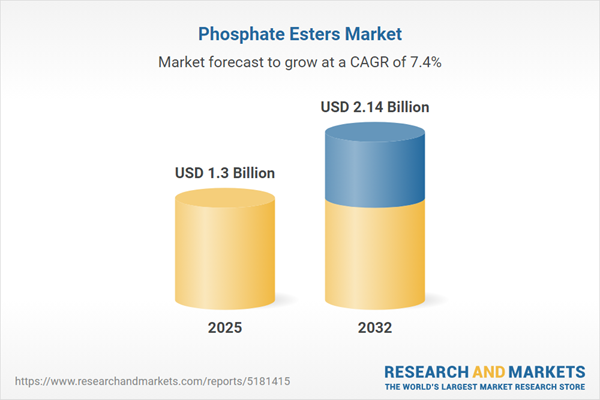Speak directly to the analyst to clarify any post sales queries you may have.
Phosphate esters play a pivotal role in enabling industries to enhance operational safety, achieve regulatory compliance, and advance sustainability agendas. For senior decision-makers, aligning with innovation in chemical solutions ensures long-term resilience and leadership amid evolving industrial demands.
Market Snapshot: Strategic Growth in the Phosphate Esters Market
The phosphate esters market is gaining momentum as diverse sectors adopt advanced chemical technologies to elevate both performance and sustainability outcomes. Currently, the market stands at USD 1.21 billion and is expected to grow substantially, projected to reach USD 2.14 billion by 2032.
This anticipated expansion is fueled by stringent global regulatory environments, continuous innovation in product development, and a broad transition toward flexible, technology-driven product offerings. Key industries such as aerospace, automotive, construction, and electronics are leveraging phosphate esters to keep pace with new requirements for workplace safety, process efficiency, and environmental stewardship. Decision-makers are adapting procurement and supply chain strategies to maintain competitiveness and address shifting regulatory and market expectations.Scope & Segmentation of the Phosphate Esters Market
- Product Varieties: Trialkyl phosphate esters improve mechanical durability in equipment, while triaryl phosphate esters offer high-performance characteristics valuable in advanced plastics applications.
- Core Applications: Primary uses include flame retardants for plastics and textiles to ensure compliance, hydraulic fluids for equipment integrity, surfactants for product uniformity, plasticizers in PVC processing, and lubricants—all supporting enhanced safety and productivity.
- End User Sectors: Aerospace relies on phosphate esters for stability under demanding conditions. Automotive, construction, and electronics sectors benefit from improved fire resistance, longer equipment lifespan, and compliance with stringent manufacturing protocols.
- Formulation Types: Solutions are available in liquid, powder, and emulsifiable concentrate forms, providing manufacturing engineers the versatility to address distinct process requirements and operating conditions.
- Regional Landscape: The market spans the Americas, Europe, Middle East & Africa, and Asia-Pacific, requiring manufacturers to tailor sourcing and compliance approaches to local standards and risk factors.
- Key Manufacturers: Industry leaders such as LANXESS AG, ALBEMARLE CORPORATION, SOLVAY SA, ICL GROUP LTD., KING INDUSTRIES INC., INNOSPEC INC., DIC CORPORATION, OQ CHEMICALS GMBH, AKZO NOBEL N.V., and HEBEI JIHENG CHEMICAL GROUP CO., LTD. are actively investing in R&D to elevate application performance and compliance.
Key Takeaways: Strategic Considerations for Senior Decision-Makers
- Integrating phosphate esters helps organizations effectively address heightened expectations for workplace safety and manage complexities in regulated sectors.
- A shift toward nonhalogenated and bio-based products underscores growing emphasis on sustainability and alignment with international compliance regimes.
- Ongoing advancements in chemical engineering, such as nanotechnology, are delivering improved thermal management designed for modern industrial systems.
- The deployment of digital modeling and lifecycle assessment drives gains in design efficiency and allows continuous optimization of chemical portfolios.
- Procurement functions are placing greater importance on secure sourcing, systematic quality control, and resource reuse to strengthen risk mitigation and ensure operational continuity.
Tariff Impact on Market Dynamics
Recent adjustments in US tariff structures have influenced global sourcing strategies and supplier networks for phosphate esters. Many organizations are now giving greater consideration to Asia-Pacific and European sources to maintain cost efficiency and reliable supply. At the same time, domestic manufacturers are prioritizing operational agility to accommodate new compliance and logistics challenges.
Methodology & Data Sources
This analysis is based on an extensive evaluation of industry-leading databases, official regulatory disclosures, and recent patent information. Expert interviews and scenario planning were employed to validate insights and ensure they are tailored to the priorities of executive leadership.
Why This Report Matters
- Equips executives with a clear understanding of how regulatory shifts and market trends are accelerating phosphate ester adoption and influencing strategic decisions.
- Outlines actionable opportunities for innovation, supply chain optimization, and enhanced operational resilience across multiple industries.
- Provides senior leadership with decision-support tools for improving risk management and building robust value-chain processes from sourcing through application.
Conclusion
Phosphate esters enable organizations to align their regulatory, technical, and sustainability initiatives while preparing for changing market dynamics. This report supports strategic planning and procurement for continued business agility and growth.
Additional Product Information:
- Purchase of this report includes 1 year online access with quarterly updates.
- This report can be updated on request. Please contact our Customer Experience team using the Ask a Question widget on our website.
Table of Contents
3. Executive Summary
4. Market Overview
7. Cumulative Impact of Artificial Intelligence 2025
Companies Mentioned
The companies profiled in this Phosphate Esters market report include:- LANXESS AG
- ALBEMARLE CORPORATION
- SOLVAY SA
- ICL GROUP LTD.
- KING INDUSTRIES, INC.
- INNOSPEC INC.
- DIC CORPORATION
- OQ CHEMICALS GMBH
- AKZO NOBEL N.V.
- HEBEI JIHENG CHEMICAL GROUP CO., LTD.
Table Information
| Report Attribute | Details |
|---|---|
| No. of Pages | 186 |
| Published | October 2025 |
| Forecast Period | 2025 - 2032 |
| Estimated Market Value ( USD | $ 1.3 Billion |
| Forecasted Market Value ( USD | $ 2.14 Billion |
| Compound Annual Growth Rate | 7.3% |
| Regions Covered | Global |
| No. of Companies Mentioned | 11 |









